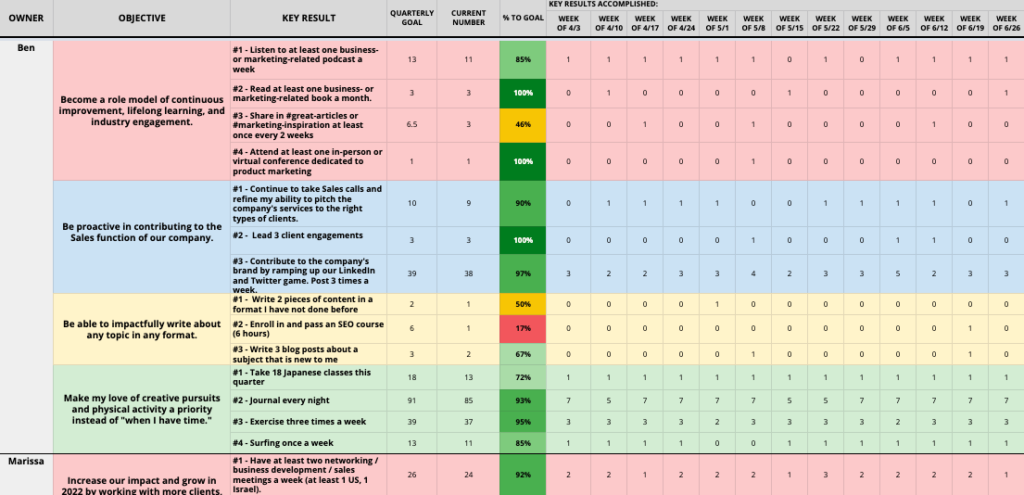Let’s play a game.
Raise your hand if you’ve ever said “I’ll work on [insert goal here]…whenever I have time.” Great. Now, raise your other hand if you’ve actually made the time to achieve this goal. If you’re like me, and most people for that matter, you’ve probably got both hands raised right now. 🙌
B2B marketing is an ever-changing field. If you’re not constantly progressing, you’re falling behind. For this reason, at Blue Seedling, learning and teaching are two of our core company values. But even for us, sometimes our loftier goals — like mastering a new channel or strengthening our time management habits — get pushed to the backburner. Luckily, we recently developed a company-wide system for committing to our long-term goals and tracking progress week-to-week. The new system has reinvigorated our work and helped us all commit even more deeply to our culture of constant learning.
In this post, we will explore the all-too-human tendency to deprioritize growth-related tasks — and we’ll share our step-by-step guide for building your own goal-tracking system to help keep you and your team on target.
The problem? It’s “mere urgency.”
The Eisenhower Matrix states that all tasks can be divided up into four categories: urgent and important, not urgent or important, urgent but not important, and important but not urgent. Urgency refers to the fact that there is a deadline to the task, while importance refers to the value that the task adds to your life or work.
Here are some examples:
- Finishing a presentation for a client = urgent and important
- Scrolling aimlessly through social media = not important or urgent
- The new message *ping* from Slack = urgent but not important
- Weekly planning, exercise, writing your book = important but not urgent
Although it’s clear from these examples that important-but-not-urgent tasks can be the most rewarding, most people by default will choose an urgent-but-not-important task over an important-but-not-urgent task. (Example: Responding to a question posed in a group chat instead of working on their book.) Why? A study in the Journal of Consumer Research describes a phenomenon known as “The Mere Urgency Effect” which states that people are more likely to prioritize a task that has a deadline over one that doesn’t, even if the task without a deadline is more rewarding.
So now we know we have psychology working against us. Lovely. What can we do to inspire ourselves and our team to constantly grow and learn, and take on tasks that are definitely important-but-not-urgent?
The solution? OKRs (Objectives and Key Results)
OKRs (Objectives and Key Results) is an established format for goal writing first espoused by VC John Doerr. The format uses the urgency effect to our advantage by converting important-but-not-urgent goals into urgent-and-important tasks.
Here’s how we define Objectives and Key Results:
- Objectives: These are your important-but-not-urgent tasks— your qualitative aspirations. They are something that you, your team, or your organization aim to achieve, and must be qualitative.
Example: Improve my writing skills. - Key Results: Key results refer to the quantifiable tasks that contribute to accomplishing your qualitative objective. We usually aim for 3 – 4 key results per objective.
Example: Key results for the “improve my writing skills” objective could be writing for 20 minutes a day, posting to your blog twice a month, and completing a writing class.
For more examples, check out some great OKRs here.
Pretty straightforward, right? All you need now is a system for you and your team to construct and stick to your OKRs. Our recommendation? OKR tracking.
OKR tracking in 4 simple steps
1) Decide on the length of your OKR cycle
The OKR cycle is the time between implementing your OKRs and your desired deadline. The key is to find an amount of time that is long enough for your team to accomplish their goals, while not being too long that it loses the urgency. We recommend a quarterly cycle (3 months per cycle), but feel free to experiment with your team over time.
2) Write your OKRs
It’s best to write your own OKRs, and then review with a buddy or a manager. When reviewing, you want to make sure that: 1) you feel passionate about your objectives (or else you won’t put in the effort to achieve them!) and 2) your key results are practical ways to achieve your objectives. Your key results should be challenging, but achievable and measurable. Make sure the quantities of your key results are appropriate for the length of the OKR cycle, i.e. that they can actually be completed within the time allotted.
3) Start tracking
An OKR tracker is a spreadsheet where everyone keeps track of their weekly progression during the OKR cycle. One column contains a progress report (such as a percent-to-goal calculation or status report) where everyone can gauge achievement “at a glance”. (Extra points if you format this column to change from red to yellow to green as you progress.) We also recommend having all team members’ goals on a single spreadsheet, one on top of the other. This makes it easier to pull inspiration from others as they achieve their goals—and it forces accountability.
For more details, check out the picture of an example OKR tracker below (or view it here). Then, check out our template and copy it to use it for your team.

Note: This part of the process can require some trial and error to get right. Sending feedback surveys from time to time is a great way to get a feel for how the team is interacting with your goal tracker and see if there are any improvements that need to be made. It also helps to send out OKR tracker reminders at the end of each week, especially during your first couple of cycles, to make sure everyone is keeping up.
4) Review
At the end of each cycle, it’s essential to review your goals. What went well? What could have gone better? How can you set yourself up to succeed in the next cycle? To do this, set up a meeting with the person who reviewed your OKRs with you at the beginning of the cycle and start by taking the average of all the key results to produce a final score for each objective. For example, if the final key result percentages for a given objective are 89%, 95%, and 90%, then your final score for that objective is (89+95+90) / 3 = 91%. Next, make a plan of action for each objective based on how successful you were with each one.
The bottom line
B2B marketing requires constant learning and growth. Due to the pull of more urgent tasks, the actual execution of this long-term growth can sometimes pose a challenge. But not to worry: by following the steps above and implementing an OKR tracking system, you can ensure that your team is constantly growing.








